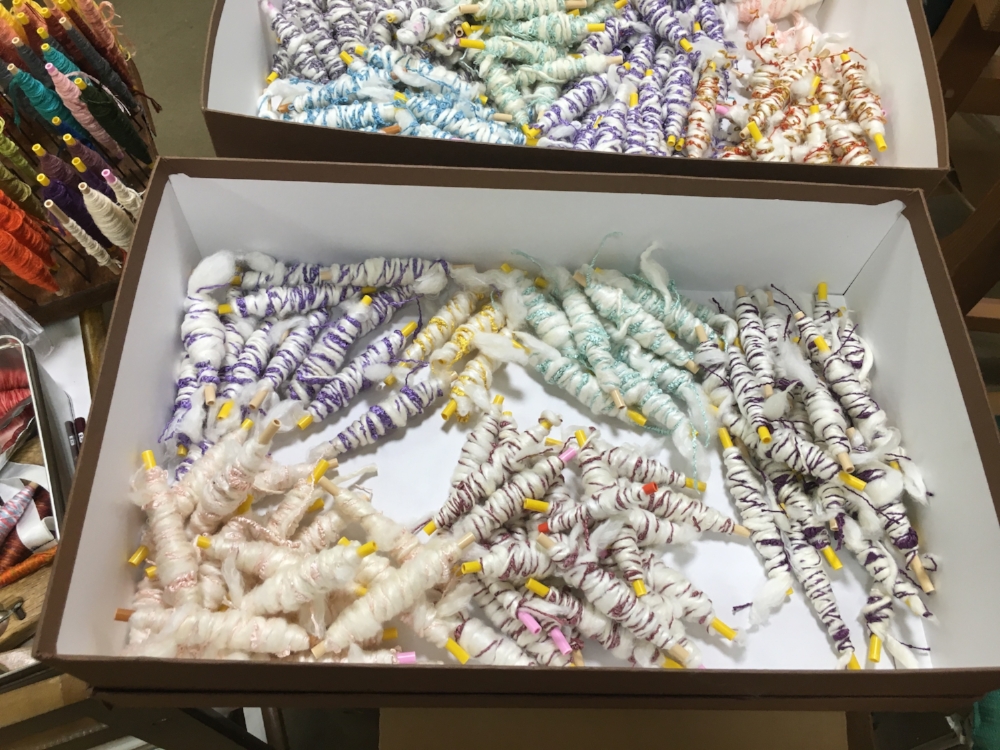Weaving is a method of fabric production in which two distinct sets of yarns or threads are interlaced at right angles to form a fabric or cloth. This year, our team was fortunate enough to visit the Nishijin district of Kyoto and acquired a thorough understanding of the technique and origin of the Nishijin weave. We are very excited to begin including this lavish fabric in our upcoming collections.
Nishijin is a district in Kamigyō-ku, Kyoto, Japan, and (by extension) a traditional textile produced there and famous for Nishijin weaving, more narrowly referred to as Nishijin-ori (Nishijin fabric). Nishijin is Kyoto’s traditional textile center, the source of all those dazzling kimono fabrics and obi (kimono sashes) that you see being paraded about town. Nishijin produces the most sophisticated and lavish Obi you will find in Japan.
A stunning Geisha's Obi in Kyoto.
The beautiful fabrics woven in the Nishijin district are seen as a symbol of Kyoto and developed over 1,000 years alongside Kyoto's history as the former capital of Japan. Nishijin-ori‘s origins are from an ancient Japanese family, the powerful Hata clan, who immigrated to Kyoto from China around the 5th-6th century. Settling in the Uzumasa district of west Kyoto, they introduced silkworms and the manufacture of silk textiles to the local people. By the 8th century, the royal court had created an official branch to supervise the textile artists and their production. In other words, these were state-owned textile operations.
In the 15th century, Kyoto suffered a long period of civil war, the Onin War, between the East and the West, and many artisans fled Kyoto to places such as the town of Sakai, south of Osaka. When the conflict finally ended, the weavers returned to Kyoto to resume their craft. One group of artisans settled on the site where the western army had been camped during the war. This is the origin of the name 'Nishijin,' which means west position. Nishijin’s literal translation is the West fort. Since then, the name has been used for the method of weaving to create designs and patterns using dyed threads in Kyoto.
Supported by the patronage of both the Imperial court and great samurai lords, the weavers continued to adopt new technology. By the early Edo Period (1603 to 1867), there were some 7,000 looms crammed into an area of 1.6 square kilometers. A combination of disastrous harvests at the end of the 18th century with Japan's capital move from Kyoto to Tokyo in 1869, Nishijin weaving seemed threatened with extinction. But the Nishijin weavers showed an amazing resilience and spirit in preserving their craft. Observers were sent to Europe to study the textile industry there, and advanced Western weaving technology and equipment were introduced from France and Austria, such as the jacquard loom and the flying shuttle. By the 1890's, only 20 years after the shift of the capital, the Nishijin weavers had fully adapted modern technology to their ancient art. By adopting modern technology with their age-old craft, the Nishijin weavers were able to create a stable business in inexpensive machine-woven fabrics for everyday use that supported the production of the elaborate and luxurious hand-woven fabrics that are the purest expression of the Nishijin style.
Many Obis.
Nishijin Obi comes in many colors, including gold, and it is glamorously thick and rich, not to mention quite heavy as well. Nishijin Obi is rather expensive items, but one is enough to last for a lifetime. Their quality and craftsmanship are remarkable and orders from famous couture designers around the world are not uncommon. The Nishijin style of weaving uses yarn dyeing, in which yarns of various colors are woven to make patterns. This technique is both time-consuming and labor intensive compared to other techniques, but it is indispensable for creating the elaborate and beautiful hand-woven kimono fabric.
Contemporary designs utilizing the Nishijin Weave is popular amongst couture designers.
Today, the clacking of looms can be heard all around the Nishijin area. The vitality of this district is a testament to the pride and dedication of Nishijin weavers through the ages and the important place that Nishijin occupies in the hearts of Kyoto people.
Author: Aruña Chong Quiroga


